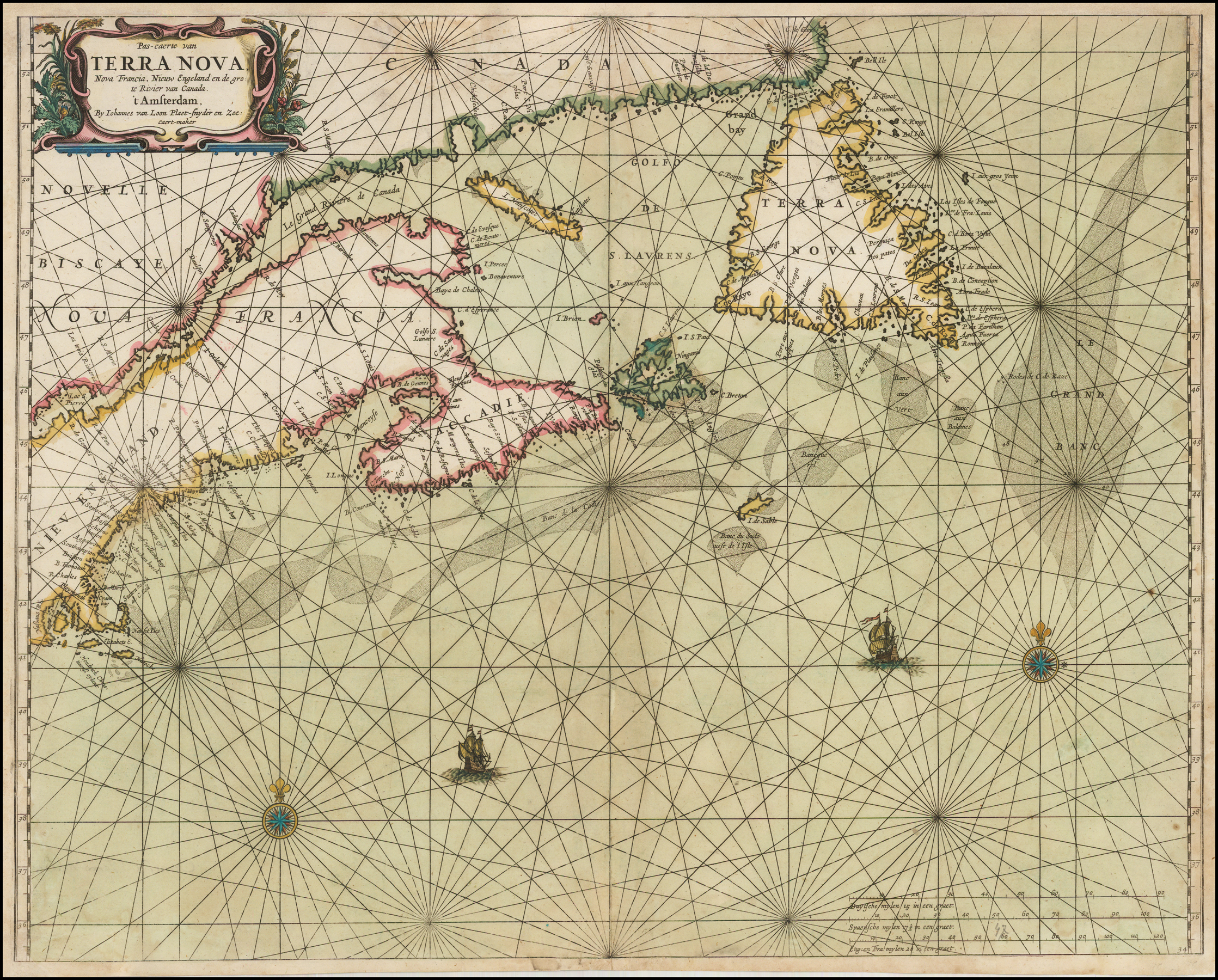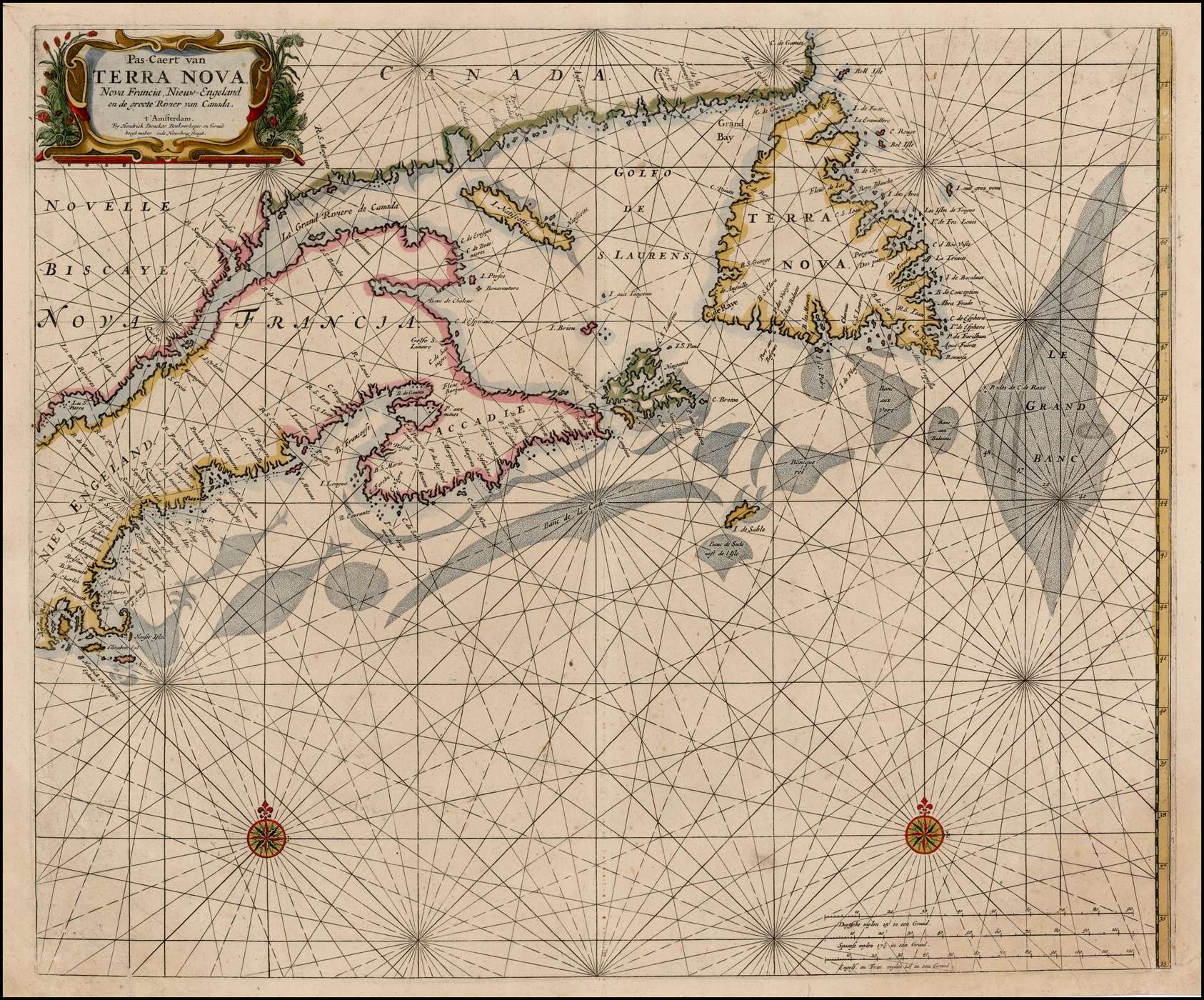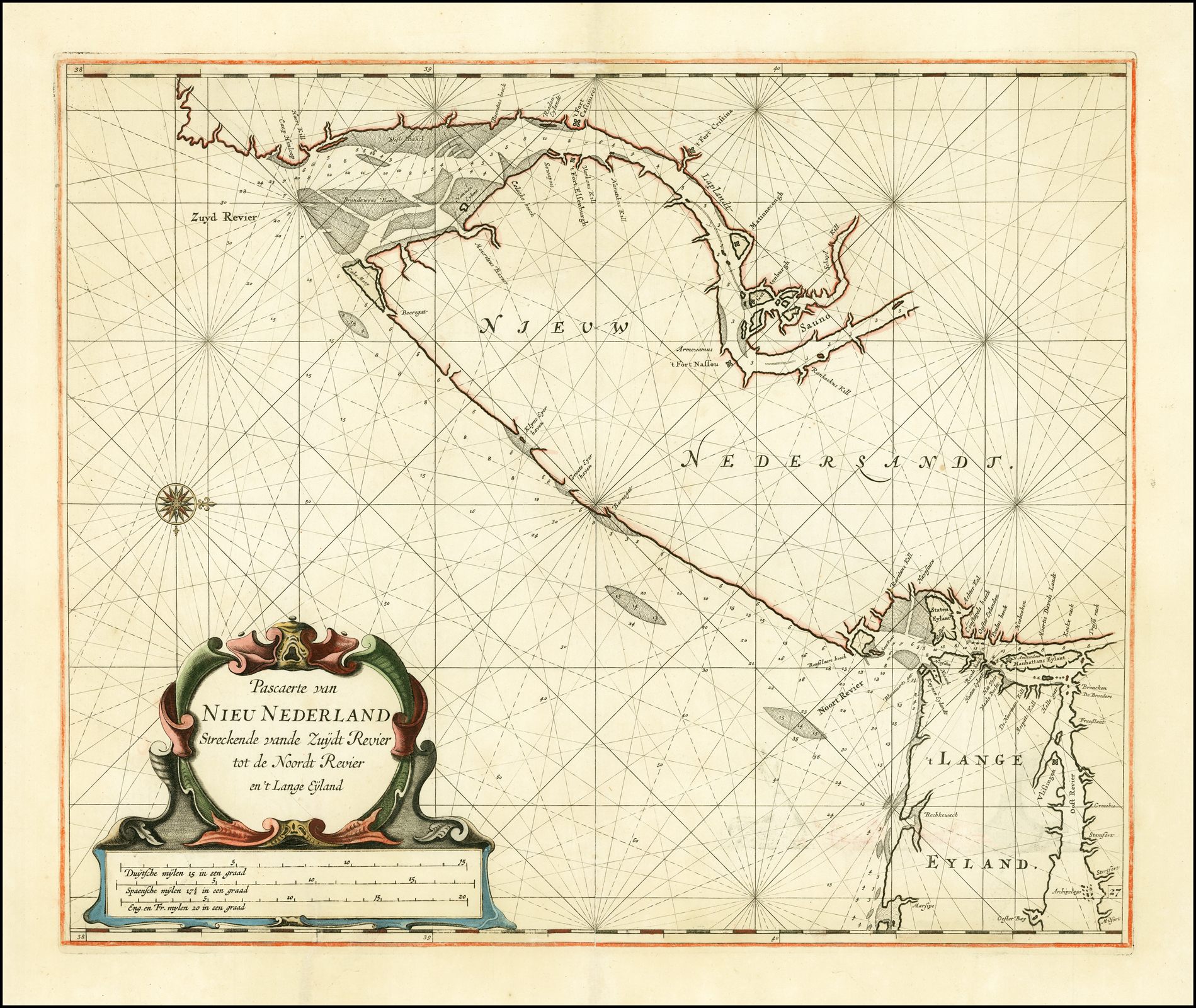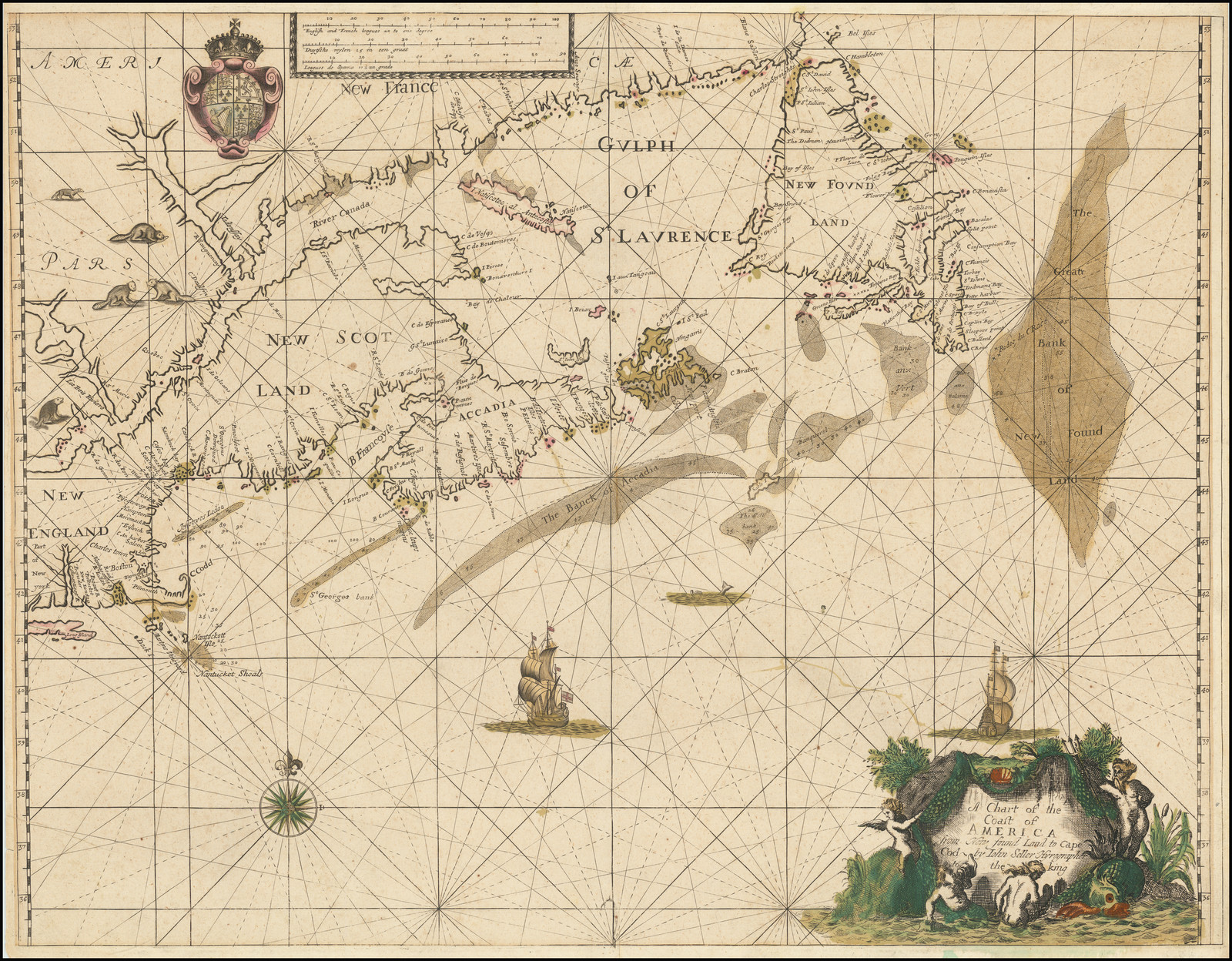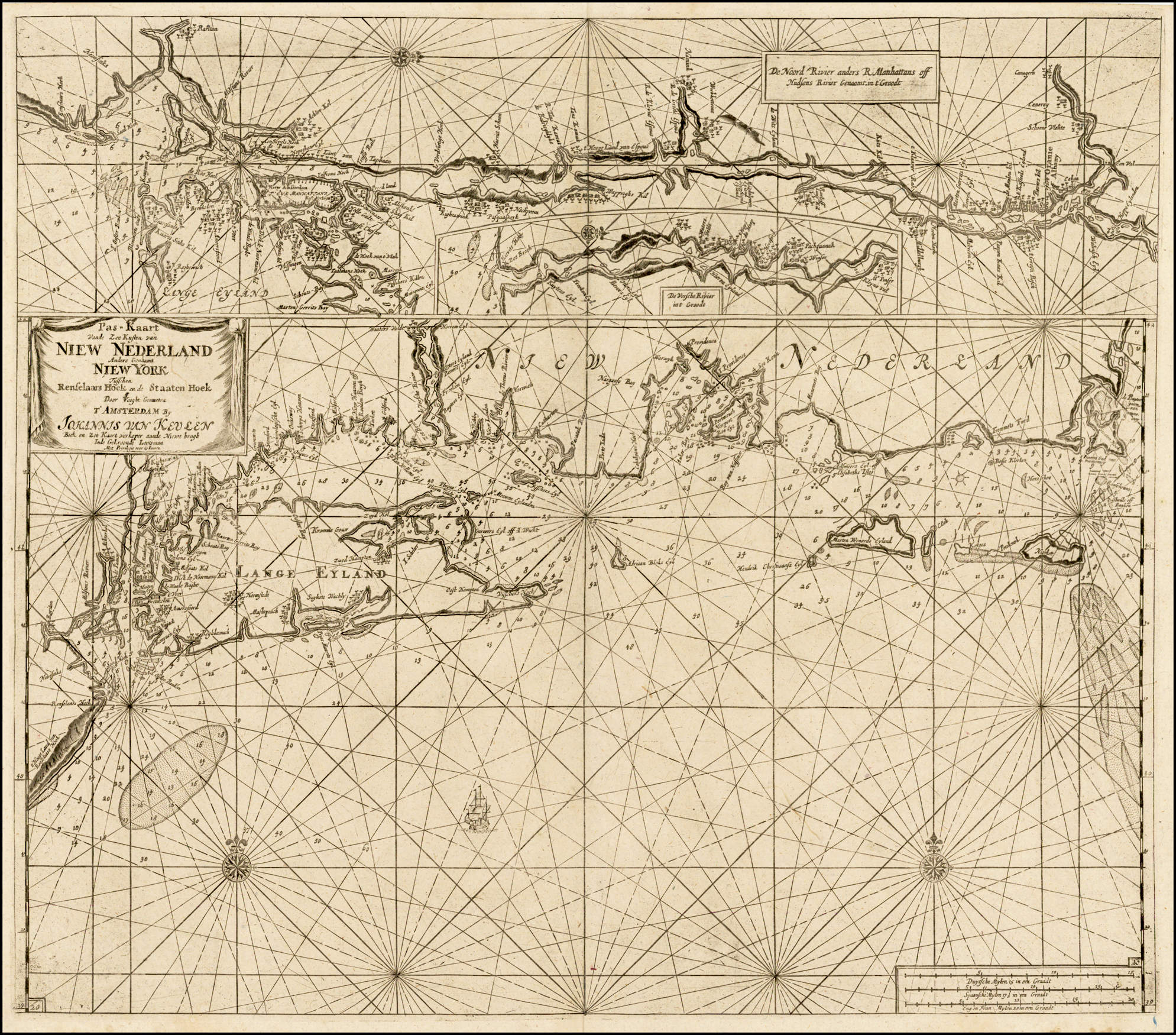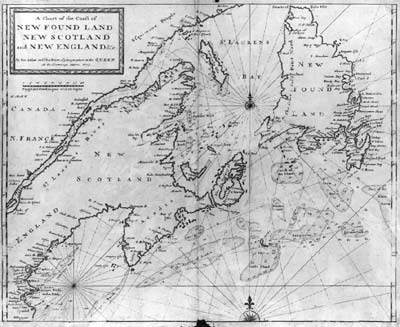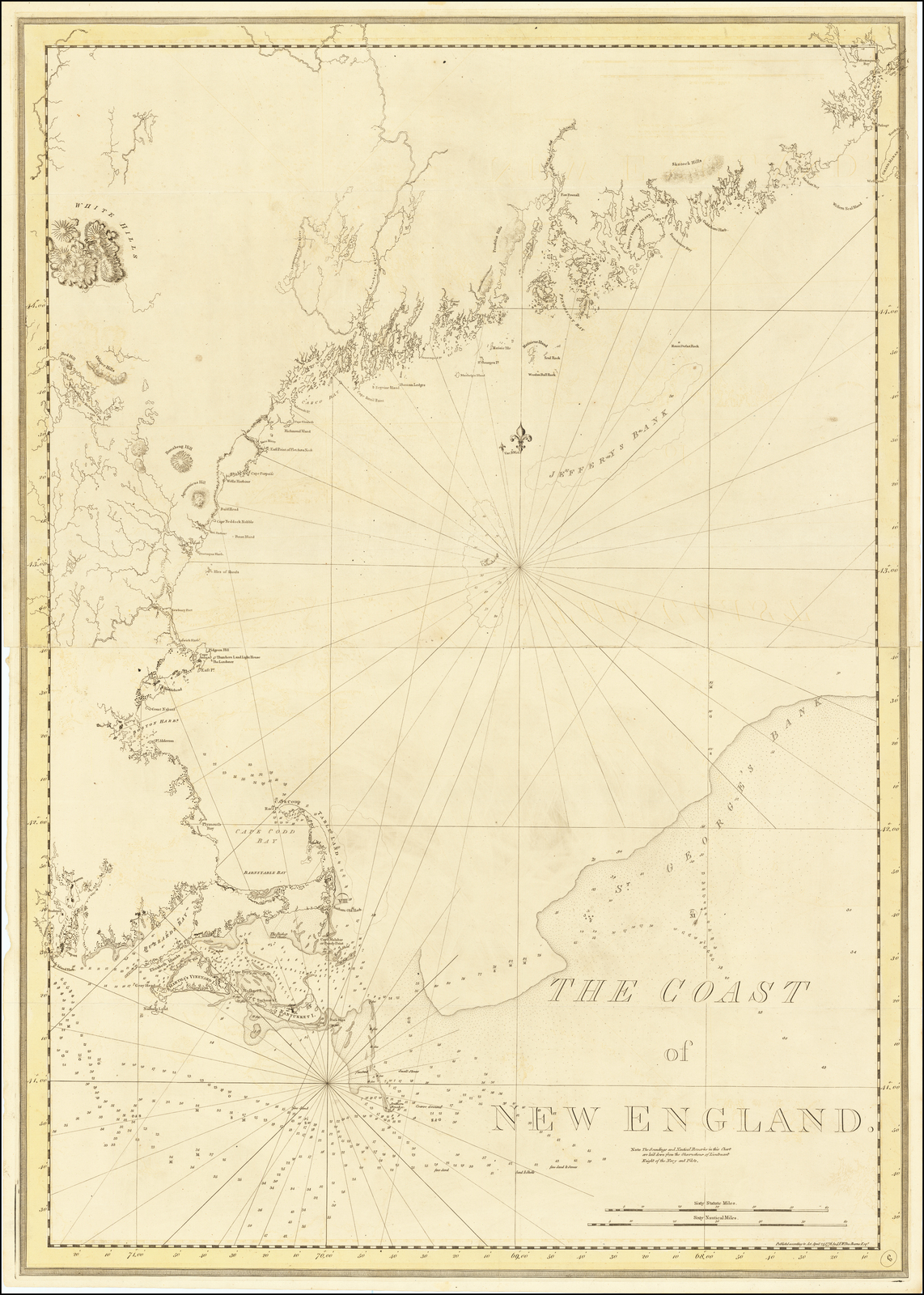The following check-list comprises printed charts of the New England region, or general charts of the eastern seaboard of North America, published between 1646 and 1785. Omitted are charts of the North Atlantic, and detailed charts of part of the coast, and individual harbours, particularly for example, from the des Barres’ Atlantic Neptune.
The earliest printed charts of the region are found in Sir Robert Dudley’s Dell’Arcano dell’Mare‘, one of the landmarks in the history of cartography. It was the first printed sea-atlas encompassing the whole world, with all the charts prepared on Mercator’s Projection (itself designed for use by seamen), with lines of latitude and longitude clearly marked.
Referring to the manuscript chart of Florida, Kohl wrote: “The observations on the wind and currents are particularly remarkable. Dudley introduced such observations on all his charts, at a time when nobody else thought of it”. (1) It is this deep-rooted scientific approach that forms the heart of Dudley’s work.
Cavendish, the navigator, so it was probably inevitable that he would go to sea. He saw service with the English fleet in operations against the Spanish in Guiana, and against Cadiz, and in the meantime received an extensive training in navigation, at which he became extremely proficient. Unfortunately, what promised to be a distinguished naval career was curtailed early. His role in court intrigues, as he attempted to secure his father’s titles for himself, earned him the queen’s disfavour, and in 1605 he was forced into exile, eventually settling in Florence.
There, under the patronage of Cosmo II and then Ferdinand II, Dudley devoted himself to maritime studies, compiling treatises on navigation and ship-building, as well as an atlas of manuscript charts, completed by about 1636, preserved in the Royal Library in Munich. which formed the basis for his printed charts.

The sources employed by Dudley are difficult to reconstruct. There is evidence on certain charts of information drawn from personal experience, but the vast majority of the charts must have relied on manuscript materials supplied by his family and friends in England, from Dutch contacts, or gathered, by personal contact or through the offices of his patron, from Italian and Spanish sources. Unfortunately, such an archive as Dudley might have compiled no longer exists, although Stokes notes the existence of six manuscript portolan charts of this period, by an English map-maker John Daniel, preserved in the Bibliotheca Palatina in Florence which may be one small part of a much more extensive collection, once owned and used by Dudley. (2)
Although the manuscript atlas was completed by about 1636, the printed atlas was not completed until 1648 – the engraver Lucini himself writing that he had spent twelve years on engraving the charts. Later writers have been very critical of Dudley the chart-maker, but considering the period in which he was working, the constraints imposed by his exile, and the weaknesses of his source material, Dudley’s charts represent an enormous scientific achievement, not challenged in approach until the advent of the quasi-official English and French ‘Admiralty’ surveys of the middle and late eighteenth centuries.
Dudley’s first chart is found in a preliminary section of large scale charts, while the second chart, ‘Nuoua Belgia’, is placed within the sequence of maps of the American coasts, and depicts a smaller area. (3) A comparison of this map with its companion reveals widely divergent detail, pointing to Dudley’s use of quite different sources for the two maps.
One of the problems often faced by map-makers who worked at second-hand was this very problem of trying to evaluate two different sources, without relevant first hand experience. Often, as is possible here, the map-maker offered both alternatives, in different maps, so that at least the navigator might have the luxury of a choice.
On the ‘Nuoua Belgia’, the toponomy of the southern New England coastline seems to point to a Dutch source, which named ‘Nuoua Amstrdamo’ (on Manhattan Island) ‘Rio Martin o R. Hudson’ ‘I: State[n].’ (albeit an the wrong island), and two forms of Manhattan: ‘Minatthans’, and ‘I. Manhatas’, both misplaced. Stokes believed the reference to Staten Island to be the first appearance of the name in a printed map. (4)
As Stokes pointed out the outline bears considerable resemblance to Block manuscript map of the region, drawn in 1614, as published by Willem Blaeu in his ‘NOVA BELGICA ET ANGLIA NOVA’ (Amsterdam, 1635), which was a land-map, rather than sea-chart.(5) There are other examples from within this sequence of information from land-maps being absorbed by chart-makers.

The first Dutch chart of the New Netherlands was prepared by Jacob Theunisz, who died in 1650, although the chart does not seem to have received wide circulation until the 1670’s. Arnold Colom’s chart of the region, which was described by Koeman as the first printed “chart of what was called ‘Nieu Nederland'” (6), seems to have proved more popular, and its influence can be seen running through the sequence of general charts of the eastern seaboard published by successive Dutch chart-makers. This map, and its companions in ‘Zee-Atlas’ are notable for their size, being engraved on a much larger format than was generally used, both in preceding and subsequent Dutch atlases.

A reference to the plates from this atlas is found in a Notary Act of 1663, ordering Colom to give them to his landlord Nicolaas Visscher (a prominent map-maker, also) as security against his unpaid rent.(7) Presumably, the debt was never paid, as no subsequent issues by Colom are known. It would appear that on the death of Colom, Visscher, who had no interest in publishing sea-atlases, sold the plates to Hendrick Doncker, because some of the plates subsequently re-appear in his ‘Vermeerderde Zee-Atlas’, from 1676 onwards.
Although Jacob Colom, Arnold’s father, had been publishing pilot-books with charts in for many years, Arnold was the first to publish a sea-atlas, and subsequently Jacob initiated his own, first published in 1663, essentially based on his son’s chart, but with new information in the New York region. A further member of the family also made a foray into chart-publishing. Pieter van Alphen was introduced to the profession on his marriage to Joanna Colom, daughter of Jacob and brother of Arnold, in 1657. With their support, Alphen published his first atlas in 1660.
Koeman wrote:
“The importance of this atlas is based on the fact that it exclusively consists of charts, used for navigation beyond coastal waters. The charts of the oceans are all drawn on the Mercator projection.”
Koeman, do, p.15: Alp 1, notes.
Hendrick Doncker was one of the most prolific and successful chart-makers in Amsterdam in the seventeenth century, issuing many different pilot-guides and sea-atlas collections. His earliest maps reflect very much Colon’s earlier work, but in contrast with many of the other publishers in this catalogue, Doncker worked hard to keep abreast of the latest discoveries, improving or replacing exiating plates, as necessary.
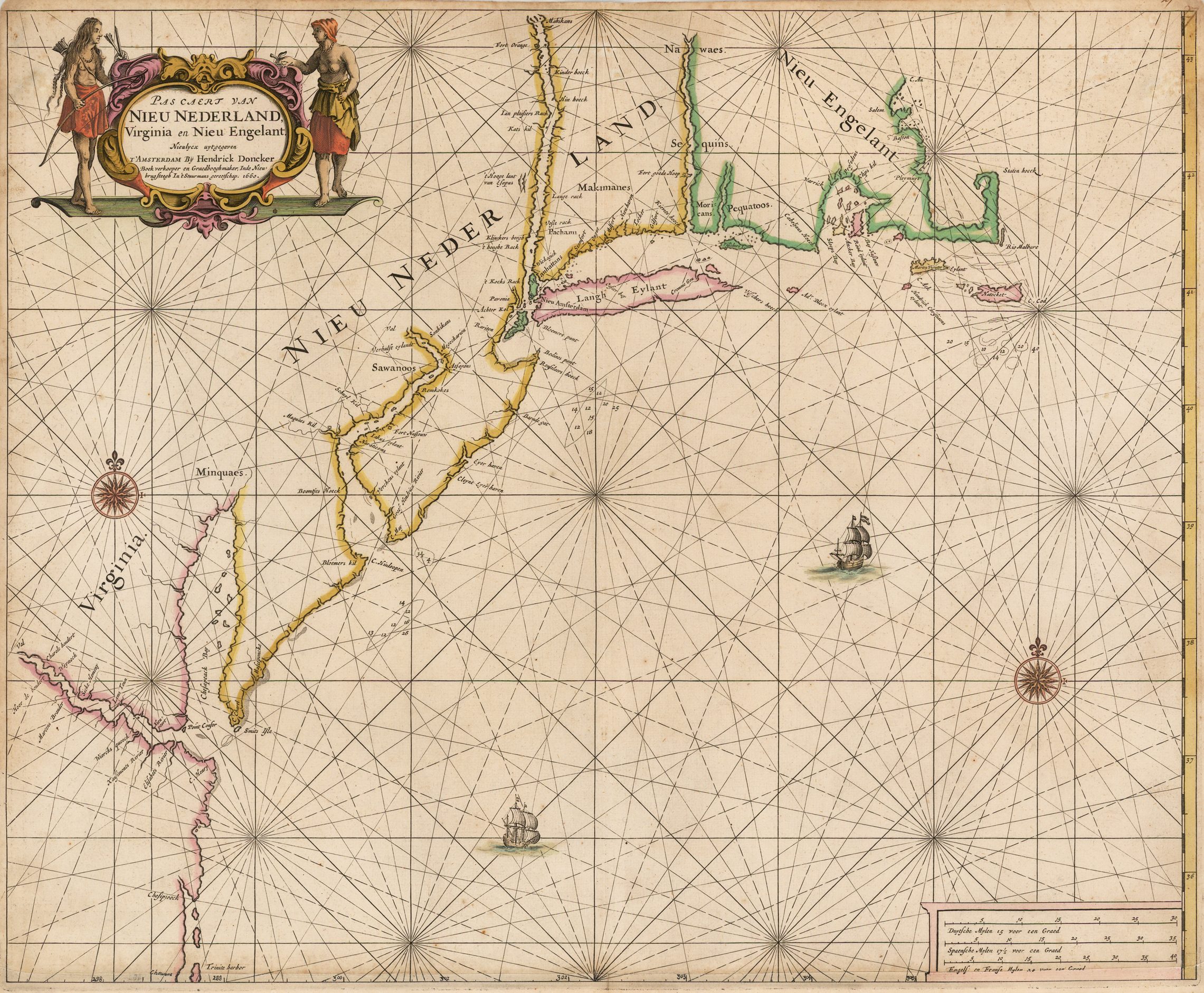
His chart of the ‘Nieu Nederland’ is a derivative of Colom’s chart, with a very similar delineation of the coast north of Chesapeake Bay, albeit with omissions of toponymy. One noticeable variation is the much rounder shape of the New Jersey coast of New York harbour. The delineation of North Carolina, is much inferior, returning to an earlier model for the Cape Hattoras banks.
In about 1672 Doncker announced his intention of producing a large-folio sea-atlas, comparable with that of Arnold Colom, in fact utilising Colon’s original plates. This plate had Doncker’s name substituted for Colom’s in about 1675, for it was then that he started using the detailed address (“the third house down from the New Bridge”), to distinguish his shop from that of a rival ships-chandler, Johannes van Keulen, who had moved into the street opposite him. (9)
This new sea-atlas, De Nieuwe Groote Vermeerderde Zee-Atlas, was published from 1676 onwards. However, both extant copies with the title-page dated 1675 are editions of the standard atlas in all other respects.
One of the problems often associated with over-size atlases was the risk of cropping the maps in binding. It is presumably for this reason that for the 1688 edition (and perhaps as early as 1675) many of these large plates were cut down to a more standard size, as was the New England chart, but in the only example of this edition of the atlas recorded by Koeman, the map has been superceded by a new plate with an inset of Philadelphia.
The foundation of Philadelphia proved a particularly influential event in cartographic history. Within a short space of time, Thomas Holme’s town plan was copied and re-issued by numbers of European map-makers. Obviously, Doncker took the opportunity to prepare a new sea-chart of New England, incorporating Holme’s plan as an inset.

This chart was subsequently re-issued by Gerard van Keulen. According to Koeman, Hendrick Doncker Jr. sold substantial parts of the business stock to Johannes van Keulen, after 1700.(10) However, two advertisements in the Amsterdamse Courant, for November 23rd and December 13th 1720, show Hendrick Doncker’s widow advertising for sale the shop in ‘de Nieuwenbrugsteeg’ with the shop-wares – “bestaende in Kaerten, Boecken, &c. en alle soorten van Stuurmans Gereedschappen.” It is more plausible that this plate was acquired by van Keulen at this later time.
Then, just as the foundation of Philadelphia provided the impetus for the original plate, so the publication of Halley’s chart of Boston harbour proved the spur that caused Gerard van Keulen to re-engrave the plate, adding the new inset of Boston harbour, and inserting his imprint
One of the most unusual charts of New England was issued by Pieter Goos, who does not have a high reputation as a chart-maker. While his charts are among the most decorative and finely engraved of any series, the information in them tends to be derivative rather than original. His general chart demonstrates appreciable differences from either Arnold Colon’s or Doncker’s charts – instead, his coastline is derived from a series of land-maps, the so-called Jansson-Visscher sequence of maps of New England, which are described and illustrated by Tony Campbell.(11) The main similarities are found in the series of banks or islands along the New Jersey coast, in the shape of Rhode Island, and in the islands off the south shore of the Cape Cod peninsula, as well as the additional toponomy associated with the Swedish and Dutch settlements along the course of the Delaware River. Because of the similarity of the maps within the sequence, it is difficult to establish which of them was actually used.

While contemporary charts of the region contain few soundings, Goos’ version is remarkable, for a chart, in having none.
Following Dudley, Dutch chart-makers came to dominate the charting of North American waters. However, in 1689, appeared the First Edition of ‘The English Pilot. The Fourth Book’, published by John Thornton and William Fisher. Evidently, Fisher provided the printing ability, while Thornton was the acknowledged chart-maker. ‘The English Pilot. The Fourth Book’ enjoyed a remarkable longevity, appearing in 37 editions from 1689 to 1794, being re-printed long after it had been superseded by better sea-atlases and pilots. Under later publishers, members of the Mount and Page families, the pilot lost its dynamism, as the publishers often preferred to replace worn out plate with newly engraved copies, rather than introduce new materials
For example, the chart of the Chesapeake Bay, first issued in 1689, was retained from 1689 to 1794, on two sets of plates. The geographical detail was revised three times by John Thornton up to 1706, but only once by members of the Mount and Page families, in 1728.
The same delineation of the eastern seaboard was used from 1702 to 1794, in two virtually identical plates, the replacement plate, without any attempt to up-date the information therein. With minor alterations, this plate was re-issued for the rest of the printing life of the ‘Fourth Book.’
By Mount and Page standards, the general charts of New England were frequently replaced: in 1731, 1764, and 1775, but it should be noted, however, that the new plates for New England reflect the availability of a better map to copy, rather than more original input on their behalf.
Cyprian Southack’s, and its Derivatives
For such an influential chart, remarkably little is known about Southack’s New England Coasting Pilot. The chart is without the name of the engraver or the printer, and is undated. Evidence from advertisements of the period shows that the plates were engraved in London, and that the earliest examples were printed there, before being shipped to the Colonies. Subsequently, it would appear that the plates were shipped to America. Dating the earliest issue presents a problem, which many commentators have been unable to resolve.

From the evidence noted by Le Gear(12), while the original manuscript draughts were complete by about 1720, the engraving and printing of the initial impressions was not completed until 1729. An advertisement, in the Boston Gazette of June 30th 1729, announced the arrival from London of fifty sets of the charts. This may well mark the arrival of the first copies for sale in America, and thus give an terminus ante quem for the publication of the completed set.
While this delay seems lengthy, it is worthwhile considering the problems of long-distance communication at this time, comparable with the experiences of Thomas Jefferson, in 1786-1787, having a single sheet map, engraved in London, and completed to his satisfaction, by one of the most prominent engravers of the day.
The set is dedicated to Francis Nicolson (on the first map) describing him as Governor of South Carolina. While his generosity (he provided nearly one half of the money raised from subscriptions) merited honourable mention, Nicholson had been forced by ill-health to step down as Governor of South Carolina in 1725, and died in 1728.
The implication is that the first sheet, and perhaps others, had been completed much earlier. Further evidence of delays in engraving the plates can be found in a letter, of February 28th 1723, from Southack’s London agent, Thomas Sandford, attributed to financial problems.
For the second edition, an inset of Louisbourg was added to the Cape Breton sheet. The New England Weekly Journal, of October 28th 1734, records the arrival of the re-engraved plate, and provides a terminus ante quem, while Southack’s text in the inset is dated October 30th 1733. This comparatively prompt re-engraving reflects increasing tension with the French, and the strategic importance of their new stronghold at Louisbourg.
Most authorities date the first issue of John Senex’s two-sheet version of Southack’s chart 1744, but a much earlier date seems more plausible. It is this author’s view – although there is not a shred of evidence to support it – that John Senex was the engraver of the eight-sheet version, and that he used his access to Southack’s materials to prepare a two-sheet version. As the original form has a complete engraved, and graduated border, round the whole map, it would seem that it was engraved prior to Southack’s addition of the Louisbourg inset, and so circa 1730, and the right-hand border was subsequently re-engraved to allow the addition of the inset.
Unfortunately, the address in the imprint was used by John from 1724, and retained by his widow, so provides no assistance. In 1728, John was elected a member of the Royal Society, and frequently used the letters after his name, for example on later states of the maps originally issued in his ‘English Atlas’, so one might have expected the letters to be included on any new map after his election, although they are not found here.
The additional sheet, with the inset of Louisbourg, found with the second state, is evidently a response to the successful expedition against that fortress by the New Englanders in 1745. Mary Senex, who was also a commercially inclined map-publisher, would have wished to exploit popular interest in the fortress, and its location. For convenience, and speed, she simply reworked this existing map to illustrate the theatre of operations.
In about 1746, Mary issued ‘A CATALOGUE of Globes, Maps, &c. made by the late John Senex, F.R.S. and continue to be sold by his widow, Mary Senex … ‘, which refers to the second state:
“A New Map, or Chart of the Coast of New-England, from Staten-Island to the Island Breton, as it was surveyed by Capt. Cyprian Southack, with a large Draught (actually taken on the Year 1744) / of the Town and Fortifications of Louisbourg, with the Forts that defend the Harbour; together with a large Plan of the Town of Boston in New-England, Price 1s. 6d.”
The plate for both the eight- and two-sheet Southack charts subsequently re-appear in the hands of William Herbert and Richard Sayer. While Sayer seems to have acquired Mary Senex’s stock, of which the two-sheet version was a part, it is less clear how the eight sheet version, with the plates presumably owned by Southack (as they do not feature in Senex’s catalogues), came into their possession. Their re-printing is tentatively dated to 1755-1757, as Mary Senex seems to have given up business circa 1753.
Both the eight-sheet and two-sheet versions are next recorded with the imprint of Mount and Page. The two-sheet version appeared in editions of the ‘Fourth Book’ from 1775 onwards. It is possible that he plates may have come into the possession of Mount and Page at an earlier date, but Sayer’s partnership with John Bennett, which commenced in 1775, and which marks an aggressive expansion of the former’s business, might have been an opportunity for him to dispose of outdated printing plates, in favour of the superior manuscript and printed materials he had acquired from Thomas Jefferys Sr.

These last issues coincide with the outbreak of the Revolutionary War, but the needs of the Royal Navy were not to be served by such outdated materials. Instead, the Admiralty looked to Joseph Frederick Wallet des Barres’ Atlantic Neptune, one of the most outstanding sea-atlases ever published.
CHECKLIST
Locations of features on the map are marked to a notional grid:
1 – 5 horizontally, a – e vertically.
“ob” signifies outside border.
Click color photos for more information
NOTES
1. quoted by Lowery, Descriptive List of Maps Of The Spanish Possessions In The United States, (Washington: Government Printing Office, 1912), p.124.
2. Stokes, I.N. Phelps The Iconography of Manhattan Island, (Reprint edition; New York: Martino Fine Books, 1998), II, p.99-100.
3. C.PL. 37 depicts the two engraved charts, C.PL.36, the manuscript original of the eastern seaboard chart.
4. Stokes, do., II, p.101-2.
5. Stokes, do, II, p.99.
6. Koeman, Dr. I.C. Atlantes Neerlandici, (Amsterdam: Theatrum Orbis Terrarum, 1970), p.115.
7. Koeman, do., p.115.
8. Koeman, do, p.15: Alp 1, notes.
9. Koeman, do, p.164.
10. Koeman, do. p.152.
11. Campbell, Tony ‘The Jansson-Visscher Maps of New England’, Chapter 8 of R.V. Tooley, ‘The Mapping of America.’ (London: Holland, Press 1980) Lowery, 133.
12. Le Gear, Clara Eli ‘The New England Coasting Pilot of Cyprian Southack’, IM XI (Reprint edition; Amsterdam: Nico Israel, 1967), p.137ff.








